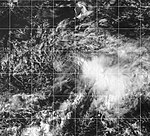2003 Pacific hurricane season
| 2003 Pacific hurricane season | |
|---|---|

Season summary map
|
|
| Seasonal boundaries | |
| First system formed | May 19, 2003 |
| Last system dissipated | October 26, 2003 |
| Strongest storm | |
| Name | Nora |
| • Maximum winds | 105 mph (165 km/h) (1-minute sustained) |
| • Lowest pressure | 969 mbar (hPa; 28.61 inHg) |
| Seasonal statistics | |
| Total depressions | 17 |
| Total storms | 16 |
| Hurricanes | 7 |
| Major hurricanes (Cat. 3+) |
0 (record low; tied with 1977) |
| Total fatalities | 23 total |
| Total damage | $129 million (2003 USD) |
| Related articles | |
| Tropical storm (SSHWS) | |
| Duration | May 19 – May 25 |
|---|---|
| Peak intensity | 60 mph (95 km/h) (1-min) 997 mbar (hPa) |
| Tropical storm (SSHWS) | |
| Duration | June 17 – June 22 |
|---|---|
| Peak intensity | 60 mph (95 km/h) (1-min) 997 mbar (hPa) |
| Tropical storm (SSHWS) | |
| Duration | June 26 – June 27 |
|---|---|
| Peak intensity | 65 mph (100 km/h) (1-min) 996 mbar (hPa) |
| Tropical storm (SSHWS) | |
| Duration | July 6 – July 8 |
|---|---|
| Peak intensity | 40 mph (65 km/h) (1-min) 1005 mbar (hPa) |
| Tropical storm (SSHWS) | |
| Duration | July 10 – July 13 |
|---|---|
| Peak intensity | 65 mph (100 km/h) (1-min) 993 mbar (hPa) |
| Tropical storm (SSHWS) | |
| Duration | July 17 – July 23 |
|---|---|
| Peak intensity | 50 mph (85 km/h) (1-min) 1000 mbar (hPa) |
| Tropical storm (SSHWS) | |
| Duration | August 7 – August 12 |
|---|---|
| Peak intensity | 60 mph (95 km/h) (1-min) 997 mbar (hPa) |
| Tropical storm (SSHWS) | |
| Duration | August 9 – August 13 |
|---|---|
| Peak intensity | 40 mph (65 km/h) (1-min) 1004 mbar (hPa) |
| Tropical depression (SSHWS) | |
| Duration | August 15 – August 17 |
|---|---|
| Peak intensity | 35 mph (55 km/h) (1-min) 1009 mbar (hPa) |
The 2003 Pacific hurricane season was the first season to feature no major hurricanes – storms of Category 3 intensity or higher – since 1977. It produced an unusually large number of tropical cyclones which affected Mexico. The most notable cyclones during the year were Hurricanes Ignacio and Marty, which killed 2 and 12 people in Mexico, respectively, and were collectively responsible for about US$1 billion (2003 USD) in damage. Three other Pacific storms, two of which were hurricanes, and three Atlantic storms also had a direct impact on Mexico. The only other significant storm of the season was Hurricane Jimena, which passed just to the south of Hawaii, the first storm to directly threaten Hawaii for several years.
The season officially started on May 15, 2003, in the eastern Pacific Ocean, and on June 1, 2003, in the central Pacific, and lasted until November 30, 2003. These dates conventionally delimit the period of each year when most tropical cyclones form in the northeastern Pacific Ocean. The season saw 16 tropical storms form, of which 7 became hurricanes, which is about average. However, this season was the first Pacific hurricane season since 1977 to have no systems become major hurricanes by reaching Category 3 or higher on the Saffir–Simpson hurricane scale.
On June 12, 2003, NOAA published a forecast for the East Pacific hurricane season, the first time it had done so. The scientists predicted a 50% chance of below normal activity this season, due to the expectation that La Niña conditions would develop. La Niña conditions generally restrict tropical cyclone development in the northeast Pacific, which is the opposite of its effect in the Atlantic.
On May 19, 2003, NOAA published its forecast for the Central Pacific hurricane season. The forecast called for a slightly below-average level of activity in 2003, due to the same forecast of the onset of La Niña which would later prompt the low forecast for the Eastern Pacific.
...
Wikipedia


















